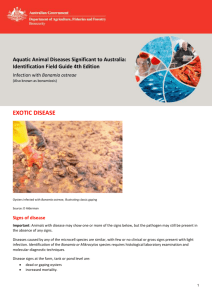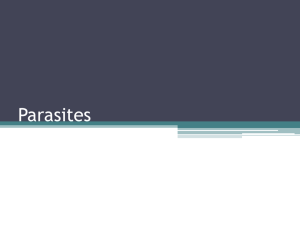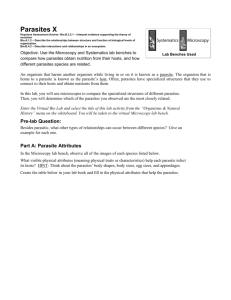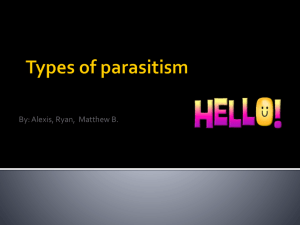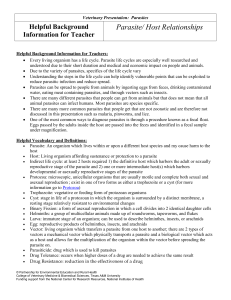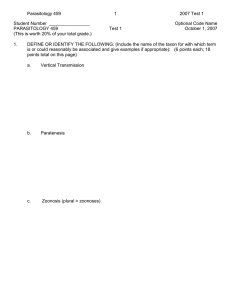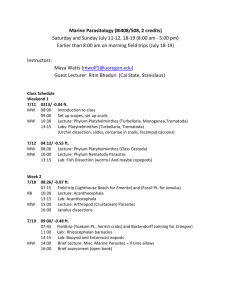Effects of temperature and salinity on the survival of Bonamia ostreae Ostrea edulis
advertisement
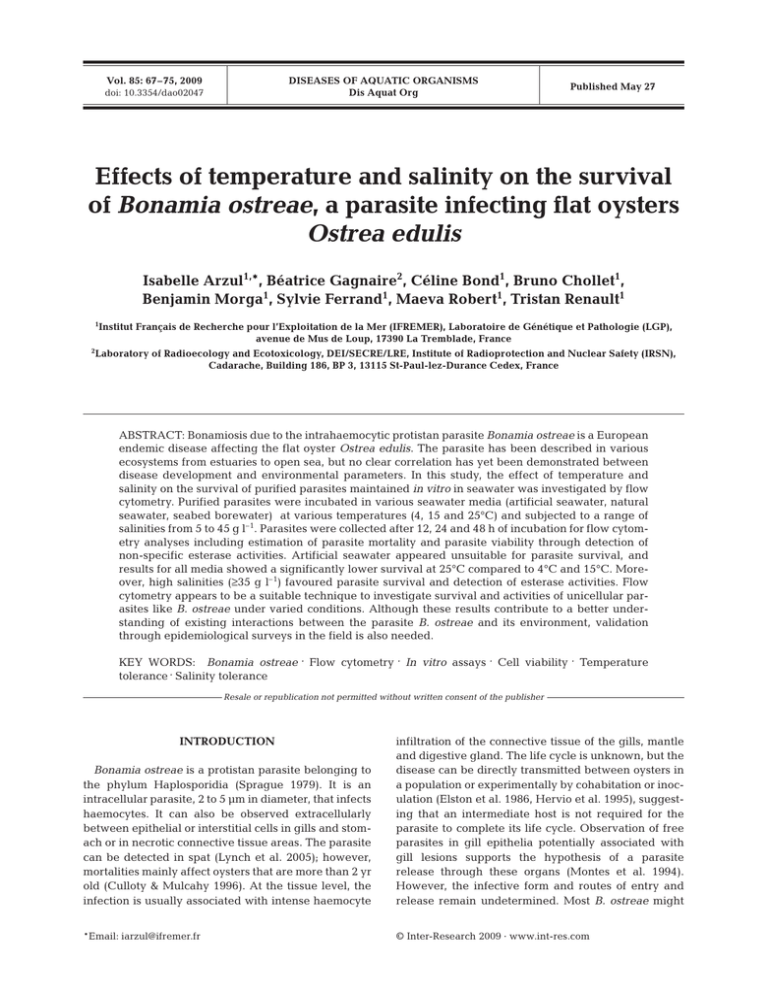
DISEASES OF AQUATIC ORGANISMS Dis Aquat Org Vol. 85: 67–75, 2009 doi: 10.3354/dao02047 Published May 27 Effects of temperature and salinity on the survival of Bonamia ostreae, a parasite infecting flat oysters Ostrea edulis Isabelle Arzul1,*, Béatrice Gagnaire2, Céline Bond1, Bruno Chollet1, Benjamin Morga1, Sylvie Ferrand1, Maeva Robert1, Tristan Renault1 1 Institut Français de Recherche pour l’Exploitation de la Mer (IFREMER), Laboratoire de Génétique et Pathologie (LGP), avenue de Mus de Loup, 17390 La Tremblade, France 2 Laboratory of Radioecology and Ecotoxicology, DEI/SECRE/LRE, Institute of Radioprotection and Nuclear Safety (IRSN), Cadarache, Building 186, BP 3, 13115 St-Paul-lez-Durance Cedex, France ABSTRACT: Bonamiosis due to the intrahaemocytic protistan parasite Bonamia ostreae is a European endemic disease affecting the flat oyster Ostrea edulis. The parasite has been described in various ecosystems from estuaries to open sea, but no clear correlation has yet been demonstrated between disease development and environmental parameters. In this study, the effect of temperature and salinity on the survival of purified parasites maintained in vitro in seawater was investigated by flow cytometry. Purified parasites were incubated in various seawater media (artificial seawater, natural seawater, seabed borewater) at various temperatures (4, 15 and 25°C) and subjected to a range of salinities from 5 to 45 g l–1. Parasites were collected after 12, 24 and 48 h of incubation for flow cytometry analyses including estimation of parasite mortality and parasite viability through detection of non-specific esterase activities. Artificial seawater appeared unsuitable for parasite survival, and results for all media showed a significantly lower survival at 25°C compared to 4°C and 15°C. Moreover, high salinities (≥35 g l–1) favoured parasite survival and detection of esterase activities. Flow cytometry appears to be a suitable technique to investigate survival and activities of unicellular parasites like B. ostreae under varied conditions. Although these results contribute to a better understanding of existing interactions between the parasite B. ostreae and its environment, validation through epidemiological surveys in the field is also needed. KEY WORDS: Bonamia ostreae tolerance . Salinity tolerance . Flow cytometry . In vitro assays . Cell viability . Temperature Resale or republication not permitted without written consent of the publisher Bonamia ostreae is a protistan parasite belonging to the phylum Haplosporidia (Sprague 1979). It is an intracellular parasite, 2 to 5 µm in diameter, that infects haemocytes. It can also be observed extracellularly between epithelial or interstitial cells in gills and stomach or in necrotic connective tissue areas. The parasite can be detected in spat (Lynch et al. 2005); however, mortalities mainly affect oysters that are more than 2 yr old (Culloty & Mulcahy 1996). At the tissue level, the infection is usually associated with intense haemocyte infiltration of the connective tissue of the gills, mantle and digestive gland. The life cycle is unknown, but the disease can be directly transmitted between oysters in a population or experimentally by cohabitation or inoculation (Elston et al. 1986, Hervio et al. 1995), suggesting that an intermediate host is not required for the parasite to complete its life cycle. Observation of free parasites in gill epithelia potentially associated with gill lesions supports the hypothesis of a parasite release through these organs (Montes et al. 1994). However, the infective form and routes of entry and release remain undetermined. Most B. ostreae might *Email: iarzul@ifremer.fr © Inter-Research 2009 · www.int-res.com INTRODUCTION 68 Dis Aquat Org 85: 67–75, 2009 be released into the water column after oyster death through tissue lysis. This intrahaemocytic parasite has been described in oysters collected from various ecosystems from estuaries and intertidal zones to deep coastal waters or lagoons and is presently reported in Europe, North America and Morocco. Northern European waters (e.g. Norwegian waters) seem to be free of bonamiosis, probably because of the lack of introduction of infected animals. Flat oysters from the Mediterranean Basin are infected by Bonamia ostreae; however, reported prevalences are low (data from REPAMO, the French network for the surveillance of mollusc diseases). No clear correlations have been demonstrated between development of the disease and environmental parameters including temperature and salinity. Previous work suggested an impact of temperature on the parasite and/or on the defence capacity of oysters. Although the disease occurs and can be transmitted throughout the year (Tigé & Grizel 1984), there is a seasonal variation in infection with B. ostreae. Prevalence of infection presents peaks in late winter and in autumn (Grizel 1985, Montes 1990, Van Banning 1991, Culloty & Mulcahy 1996, Arzul et al. 2006). A study of bonamiosis prevalence as well as haemocyte activities according to temperature showed that prevalence was higher at low temperature (10°C) compared to higher temperature (20°C), suggesting that low temperatures may affect defence capacities of the oyster and/or the ability of the parasite to infect healthy oysters (Cochennec & Auffret 2002). The lack of suitable tissue culture systems and mollusc cell lines for the culture of the parasite led to the development of a purification protocol (Mialhe et al. 1988). The availability of purified Bonamia ostreae suspensions allowed experimental infections based on parasite injection (Hervio et al. 1995) and investigations on in vitro interactions between parasites and haemocytes (Chagot et al. 1992, Mourton et al. 1992). Despite possible survival of purified parasites in filtered sea water (2 wk) as assessed by the success of experimental infection (Grizel 1985), purified parasite suspensions have not yet been used to study parasite physiology or its behaviour related to environmental conditions. In aquatic ecology, flow cytometry is classically used to determine abundance, viability and activity of microorganisms including viruses, bacteria, microalgae and planktonic protozoan parasites (Wong & Whiteley 1996, Lindström et al. 2002, Parrow & Burkholder 2002, Binet & Stauber 2006, Hammes et al. 2008). Recent developments have aimed at addressing some questions in environmental microbiology, including studying microbial physiology under environmentally relevant conditions (Czechowska et al. 2008). Flow cytometry has been successfully used to measure cell viability of cultured Perkinsus marinus, a parasitic protozoan of the eastern oyster Crassostrea virginica (Soudant et al. 2005). This tool allows multiparametric analyses on a large number of cells in a very short time and thus presents advantages over microscopic approaches. The objectives of our study were to test survival of purified Bonamia ostreae in different sea water media (artificial seawater, natural seawater and seabed borewater) in order to identify the most suitable medium for parasite preservation and to investigate effects of temperature and salinity on the survival of purified parasites by flow cytometry. Purified B. ostreae were suspended and maintained in vitro in the 3 different media at 3 different temperatures and then subjected to a range of salinities in the optimal medium previously defined. Parasite mortality was measured by flow cytometry using propidium iodide staining, and parasite viability was estimated by measuring esterase activities using fluorescein diacetate (FDA). Esterases are enzymes belonging to the group of hydrolases and are classically measured to estimate global levels of viable cell activities (Gagnaire et al. 2006a, Berney et al. 2008, Rault et al. 2008). In vitro exposure of purified parasites to ranges of temperature and salinity may improve our knowledge of the disease epidemiology and may provide guidance for oyster farmers for stock management. MATERIALS AND METHODS Bonamia ostreae purification. Purification of parasites was performed following the protocol of Mialhe et al. (1988) using flat oysters that originated from Quiberon Bay (France), an area infected by B. ostreae. Oysters were maintained for 30 d in raceways of 120 l receiving a constant flow of external seawater at a temperature of 12 to 15°C and enriched in phytoplankton (Skeletonema costatum, Isochrysis galbana, Chaetoceros gracilis and Tetraselmis suecica). Some highly infected Ostrea edulis were selected by examination of heart tissue imprints under light microscopy. Two to 3 highly infected oysters were used per purification. All organs were homogenised except the adductor muscle. Parasites were concentrated by differential centrifugation on sucrose gradients and then purified by isopycnic centrifugation on a Percoll gradient. Centrifugations were performed at 8°C. Lastly, purified parasites were resuspended in 1 ml of 0.22 µm filtered seawater before being counted using a Malassez-cell haemocytometer. Parasite suspensions were then maintained at 4°C. Salinity of filtered seawater fluctuated between 30 and 34 g l–1. Arzul et al.: Bonamia ostreae survival in seawater Experimental design. Two sets of experiments were performed 3 times. In the first set of experiments, purified parasites were suspended in 3 different media, and 10 ml of each parasite suspension were distributed in equivalent numbers (5 × 106 cells ml–1) in nine 15 ml polypropylene tubes per medium. The 3 media were (1) 0.22 µm filtered prepared artificial seawater (ASW) with a salinity of 23.4 g l–1 and a pH of 6.5 (23.4 g NaCl, 1.5 g KCl, 1.2 g MgSO4· 4H2O, 0.2 g CaCl2 · 2H2O, H2O q.s. 1 l) (2) 0.22 µm filtered seabed borewater (SBW) showing a constant salinity of 32 g l–1 and a pH of 7.06 (collected at a depth of 110 m at IFREMER facilities in La Tremblade, France) (3) 0.22 µm filtered natural seawater (NSW) from La Seudre estuary, Charente Maritime (France) with a salinity of 30 to 34 g l–1 and a pH of 8.06. Parasites maintained in the 3 different media were subjected to 3 different temperatures: 4, 15 and 25°C (3 tubes per condition). The different parasite suspensions were tested by flow cytometry after 12, 24 and 48 h of incubation. Regarding parasite survival according to previously tested medium and temperature, the second set of experiments, aimed at testing effects of salinity on Bonamia ostreae viability, was performed in SBW (stable composition compared to NSW) at 15°C (which better reflects natural conditions than does 4°C). More precisely, purified parasites were diluted in 0.22 µm filtered SBW and distributed in equivalent numbers (5 × 106 cells ml–1) in 15 ml polypropylene tubes. Distilled water or natural salt from Guérande (Pays de la Loire, France) was added to obtain a range of salinities: 5, 15, 20, 25, 30, 35, 40 and 45 g l–1. Parasite suspensions (3 tubes per salinity condition) were incubated at 15°C, and samples were analysed by flow cytometry after 12 and 48 h. Analysis of viability of Bonamia ostreae by flow cytometry. Flow cytometry protocols used in this study 69 were adapted from protocols previously described for Crassostrea gigas haemocytes (Gagnaire et al. 2006b). Each measure was carried out 3 times. For each sample, 5000 events were counted using an EPICS XL 4 (Beckman Coulter). Results were depicted under biparametric representations (density plots) showing parasite cells according to the Forward Scatter (FSc) in abscissa and Side Scatter (SSc) in ordinate and the fluorescence channel corresponding to the marker used. FSc and SSc values, which correspond to diffracted light on the acute and right angles, are proportional to cell size and cell complexity, respectively. Recorded fluorescence depended on the monitored parameters: non-specific esterase activities were measured using green fluorescence (fluorescence detector FL1), while cell mortality was measured using red fluorescence (fluorescence detector FL3). Parasite mortality was estimated after incubating 200 µl of parasite suspensions at 5 × 105 cells ml–1 in the dark for 30 min at 4°C with 10 µl of the nucleic acid fluorescent dye propidium iodide (PI, 1.0 mg l–1, Interchim). Non-specific esterase activities were evaluated by incubating 200 µl of parasite suspensions at 5 × 105 cells ml–1 in the dark for 30 min at ambient temperature with 1 µl of the liposoluble substrate fluoresceine diacetate (FDA, 400 µM in DMSO, Molecular Probes, Invitrogen). Dead parasites, prepared by boiling cells for 15 min, were used to control efficacy of PI for mortality measurement. The FL3 fluorescence histogram showed that 98.1% of PI-stained cells (red fluorescence above 1) were dead (Fig. 1a). Suspension of live parasites was used to control efficacy of FDA for esterase activity measurement (Fig. 1b). The FL1 fluorescence histogram showed that 91% of fluorescent cells after incubation with FDA (green fluorescence above 1) were alive and presented esterase activity (Fig. 1b). Fig. 1. Bonamia ostreae. (a) Red fluorescence of parasites after boiling and staining with propidium iodide. Bracket A corresponds to non-stained cells (= live cells) and Bracket B corresponds to stained cells (= dead cells). (b) Green fluorescence of parasites just after purification, in the presence of fluoresceine diacetate. Bracket A corresponds to non-fluorescent cells (= non-active cells) and Bracket B corresponds to fluorescent cells (= active cells) 70 Dis Aquat Org 85: 67–75, 2009 Statistical analysis. Data were analysed using the software Statgraphics® Plus version 5.1. Results were expressed as percentages of positive cells. Mean and SD were calculated for each triplicate. The effect of tested conditions was evaluated by 1-way, 2-way and 3-way analyses of variance (ANOVAs). Values were converted into r angular arcsinus √(% of positive cells) before analysis to ensure respect of a priori assumptions of normality and homogeneity. In the case of rejection of H0, an a posteriori least significant difference test was used to compare differences between means and to obtain hierarchy between studied factors. Significance was concluded at p ≤ 0.05. RESULTS Size and complexity of parasites Size and to a lesser degree complexity of parasites varied according to whether they were dead or alive. Irrespective of the tested conditions, it was possible to identify 2 populations of parasite cells (Fig. 2a): population A, comprising 53 ± 24% of live cells and population B, smaller in size and consisting of a majority of dead cells (mean 74 ± 23%). Some parasite cells were not included in population A or B and corresponded generally to dead cells showing higher size and higher complexity than cells included in populations A and B. For parasites maintained in NSW at 4°C 12 h after purification, populations A and B included 75.8% and 15.7% of total cells, respectively (Fig. 2a). When only considering non-PI-stained parasites under the same experimental conditions, populations A and B included 91% and 6.5% of live cells, respectively (Fig. 2b). After boiling, when only considering PI-stained cells, populations A and B included 8.6% and 88% of dead cells, respectively (Fig. 2c). Population A included more live cells (77.6 ± 6.2%) when mortality rates were below 50% compared to mortality rates above 70% (37.3 ± 24.7%; Table 1). In contrast, population B included more dead cells when mortality rates were high (91.7 ± 7.4% for mortality rates above 70%; Table 1). Effect of medium on cell viability In the 3 experiments simultaneously testing the effect of medium, temperature and incubation time on parasites (3-way ANOVA), medium was the most important factor in parasite survival (p = 0) and influenced cell mortality and esterase activity more than did temperature and incubation time (Table 2). Irrespective of incubation time and temperature, parasites Fig. 2. Bonamia ostreae. (a) Parasites maintained in natural seawater at 4°C 12 h after purification. This cytogram shows both propidium iodide (PI)-stained and non-stained cells. Population A: 75.8% of total cells; population B: 15.7% of total cells. (b) Parasites maintained in natural seawater at 4°C 12 h after purification. This cytogram only shows non-PI-stained cells. Populations A and B include 91% and 6.5% of live cells, respectively. (c) Parasites after boiling. This cytogram only shows PI-stained cells. Populations A and B include 8.6% and 88% of dead cells, respectively. FSc/SSc: forward/side scatter, respectively Arzul et al.: Bonamia ostreae survival in seawater 71 Table 1. Bonamia ostreae. Distribution of cells in percentages (means ± SD) belonging to populations A and B (as shown in Fig. 2; see text for details) and composition of live and dead cells in these 2 populations according to the parasite mortality rate Mortality rate < 50% ≥50% and < 70% ≥70% Population A Population A live Population B Population B dead 56.68 (± 18.11) 50.29 (± 20.78) 25.64 (± 17.06) 77.58 (± 6.21) 56.35 (± 9.16) 37.33 (± 24.56) 15.66 (± 5.16) 22.74 (± 10.65) 49.51 (±14.44) 53.54 (± 22.03) 74.99 (± 13.79) 91.67 (± 7.43) Table 2. ANOVAs comparing the percentages of mortality and the percentages of cells positive for esterase activity according to medium, temperature (Temp) and incubation time (Time). NSW: natural seawater, SBW: seabed borewater, ASW: artificial seawater. Terms significant at p < 0.05 are highlighted in bold and compared using a least significant difference (LSD) test df Time Medium Temp LSD tests 2 2 2 Cell mortality F 0.47 31.68 6.81 Medium ASW > NSW = SBW Temp 4°C = 15°C < 25°C Esterase activity p F p 0.630 0.000 0.002 6.35 8.96 5.10 Medium ASW < NSW = SBW Temp 4°C > 15°C = 25°C Time 12 h > 24 h = 48 h 0.003 0.000 0.009 showed significantly better survival in NSW and SBW than in ASW (Fig. 3, Table 2). However, there was no significant difference between mortality and esterase activity percentages in NSW and SBW. Mean parasite mortality was 29.1%, 31.4% and 71.1% in NSW, SBW and ASW, respectively. The percentage of parasites positive for esterase activity was 44.9 ± 7.8% in NSW, 48.2 ± 6.5% in SBW and 30.6 ± 4.1% in ASW. Effect of temperature on cell viability Parasite viability fluctuated according to the tested temperature. Irrespective of medium and incubation time, mortality appeared significantly higher at 25°C compared to 15°C and 4°C, and percentages of cells presenting esterase activity were higher at 4°C compared to 15°C and 25°C (3-way ANOVA, Table 2). In NSW, irrespective of incubation time, mortality percentages ranged from 11.92 to 25.59% at 4°C, from 16.2 to 31.83% at 15°C and from 39.26 to 75.55 at 25°C (Fig. 4). Cell mortality was thus higher at 25°C compared to 4°C and 15°C, especially after 24 and 48 h of incubation (p < 0.0001; Fig. 4). In SBW, irrespective of incubation time, the percentage of parasites positive for esterase activity ranged from 52.49 to 73.67% at 4°C, from 31.27 to 43.73% at 15°C and from 21.89 to 53.28% at 25°C (Fig. 5). Effect of incubation time on cell viability Fig. 3. Bonamia ostreae. General means and SE of cell mortality and esterase activity per medium (time and temperature data pooled); n = 27 replicates. NSW: natural seawater; SBW: seabed borewater; ASW: artificial seawater Irrespective of medium and temperature, incubation time did not have a significant effect on parasite mortality. However, a difference in the percentages of cells presenting esterase activity was noted between 12 and 24 h of incubation (p = 0.003; 3-way ANOVA, Table 2). In NSW and SBW, parasite survival and parasites presenting esterase activity were higher at 4°C and 15°C than at 25°C, especially after 48 h of incubation (Figs. 4 PI-stained cells (%) 72 Dis Aquat Org 85: 67–75, 2009 *** 90 80 70 60 50 40 30 20 10 0 *** Effect of salinity on cell viability 12 h 24 h 48 h 12 h 4°C 24 h 48 h 12 h 15°C 24 h 48 h 25°C Fig. 4. Bonamia ostreae. Mortality (percentages of propidium iodide [PI]-stained cells) in natural seawater according to the temperature and incubation time (values are means + SE of 3 replicates); ***p < 0.0001 compared to data at 25°C 12 h after incubation and compared to data at 4°C and 15°C Positive cells (%) 90 80 70 60 50 40 30 20 10 0 *** 12 h 24 h 48 h 12 h 4°C 24 h 48 h 12 h 15°C 24 h 48 h 25°C Fig. 5. Bonamia ostreae. Esterase activity (percentages of positive cells) in seabed borewater according to the temperature and incubation time (values are means + SE of 3 replicates); ***p = 0.0004 compared to data at 25°C 24 h after incubation & 5). In NSW, after 48 h of incubation, mean parasite mortality was 75.55%, 31.83% and 14.73% at 25°C, 15°C and 4°C, respectively (Fig. 4). At 25°C, mortality was significantly higher after 24 and 48 h of incubation compared to 12 h (p < 0.0001). Similarly, the percentage of parasites presenting esterase activity significantly decreased at 25°C after 48 h of incubation. In PI-stained cells (%) SBW at 25°C, the percentage of positive cells was 47.23 ± 13.31% after 24 h and 23.54 ± 8.65% after 48 h (p = 0.0004; Fig. 5). Incubation length had no significant effect on cell mortality (2-way ANOVA: F1 = 1.81, p = 0.186). Therefore, data obtained on independent samples after 12 and 48 h of incubation were pooled. A posteriori tests showed that salinities of 5, 15 and 20 g l–1 were associated with the highest mortality, whereas salinities of 35, 40 and 45 g l–1 allowed better parasite survival (Fig. 6). Higher percentages of cells positive for esterase activity were found at higher salinities (35 to 45 g l–1; Fig. 7). Moreover, incubation time had a significant effect on parasite esterase activity (2-way ANOVA, F = 15.3, p = 0). There was a significant decrease in the percentage of positive parasites between 12 and 48 h irrespective of tested salinities except at 25 g l–1 (Fig. 7). DISCUSSION Despite 25 yr of research on the protozoan Bonamia ostreae, its life cycle is poorly known. Regardless of the date at which naïve oysters are placed in an infected area, the first known stages of the parasite are observed 3 to 5 mo after exposure to the parasite (Tigé & Grizel 1984, Montes 1991). Moreover, the infection seems to remain present in areas that have been cleaned and that have ceased to produce 100 90 80 70 60 50 40 30 20 10 0 5 15 20 25 Salinity (g 30 35 40 45 l–1) Fig. 6. Bonamia ostreae. Mortality (percentages of propidium iodide [PI]-stained cells) according to the salinity of seabed borewater (all time data were pooled). Values are means ± SE. N = 6 replicates Arzul et al.: Bonamia ostreae survival in seawater 73 ostreae become smaller. Such a phenomenon has been described in apoptotic 50 cells (Cotter et al. 1992, Samali & Cotter 40 *** *** *** 1999, Nasirudeen et al. 2001). 30 *** Results showed a better survival of 20 purified Bonamia ostreae (60 to 80%) in filtered NSW and in filtered SBW than in 10 *** *** *** filtered ASW (less than 40%) regardless 0 of temperature and incubation time. This 12 h 48 h 12 h 48 h 12 h 48 h 12 h 48 h 12 h 48 h 12 h 48 h 12 h 48 h 12 h 48 h 5 15 20 25 30 35 40 45 result could be explained by a difference –1 in pH. Indeed, pH of ASW used in this Salinity (g l ) study was more acid (6.5) than NSW Fig. 7. Bonamia ostreae. Esterase activity (percentages of positive cells) in seabed borewater according to the salinity and incubation time (values are (8.06) and SBW (7.06). The effect of pH means of 3 replicates; bars represent SE); ***p < 0.001 compared to data 12 h on parasite viability was not investigated after incubation in the present study. Moreover, a difference in salinity was also noticed between tested media: between 30 and 34 g l–1 for –1 NSW, 32 g l for SBW and 23.4 g l–1 for ASW. Thereoysters for several years (Van Banning 1988). The lagtime before infection and persistence of the disease in fore, in addition to being more acidic, ASW had a lower cleaned areas have motivated some authors to investisalinity than the other tested media, which could gate potential involvement of macroinvertebrate and explain the poor survival of parasites. zooplankton species in the B. ostreae life cycle (Lynch Although no significant differences in mortality and et al. 2007). Nevertheless, considering the correlation non-specific esterase activity were observed between between density of oysters and prevalence of parasites maintained at 4°C and 15°C in NSW or SBW, bonamiosis (Grizel 1985, Hudson & Hill 1991), the par25°C did not appear suitable for parasite survival. asite mainly depends on flat oysters Ostrea edulis for Under natural conditions, the disease is reported in its survival and spread, and other aquatic organisms areas where seawater temperature rarely reaches might not be involved as important carriers or trans25°C except in the Mediterranean Sea, where Bonamia mitters (Van Banning 1988). Transmission of B. ostreae ostreae has been reported but with low prevalence between oysters probably occurs through the water (0.9 ± 1.4%; data from REPAMO, the French network column. Water characteristics can affect the survival of for the surveillance of mollusc diseases). In Quiberon the parasites released outside the host, and these charBay (Morbihan, France) where the prevalence of acteristics can influence the infective capacity of B. bonamiosis has been estimated at 12.4% ± 6.5 (data ostreae as well as the number of oysters newly from REPAMO), summer water temperatures fluctuinfected. ated between 16.9 and 19.6°C between 1989 and 2003, In that context, the effects of 2 environmental parawith a mean estimated at 18.5°C (data from REPHY, meters, salinity and temperature, on parasite viability the French network for the surveillance of phytoplankwere investigated at different incubation times: 12, 24 ton and phycotoxins). Some analyses revealed a negaand 48 h. Trials were stopped at 48 h because some tive correlation between high summer water temperapreliminary results were not reproducible beyond this ture and number of infected oysters detected during incubation time. In addition, the suitability of 3 differthe following winter (I. Arzul unpubl. data), suggesting ent seawater media for parasite preservation was that higher temperatures do not favour infection of tested: 0.22 µm filtered NSW; 0.22 µm filtered SBW oysters. A study on Crassostrea gigas haemocytes (with a constant composition) and 0.22 µm filtered showed that an increase in temperature and a ASW (which is easy to acquire and has a constant comdecrease in salinity induced an increase in cell mortalposition). ity (Gagnaire et al. 2006a), suggesting that these enviSize and complexity of Bonamia ostreae were generronmental parameters also have an effect on oyster ally homogeneous but depended on the status of the defence capacities. Similarly, previous work has parasite cells, i.e. whether they were live or dead. Two demonstrated an effect of temperature on flat oyster populations were distinguished: a homogeneous popuOstrea edulis defence mechanisms (Cochennec & Auflation of small parasites corresponding mainly to dead fret 2002); lower temperatures were associated with cells and increasing proportionally to recorded mortalincreased prevalence of bonamiosis. However in the ity, and another population that was less homogeneous same study, haemocyte activities were tested by flow and larger in size increasing proportionally to survival cytometry and revealed that low temperature (10°C) or rates. These results suggest that when dying, B. a decrease in temperature (from 20°C to 10°C) induced Positive cells (%) 60 74 Dis Aquat Org 85: 67–75, 2009 a decrease in enzymatic activity, including production of reactive oxygen species involved in defence mechanisms. Several authors described a seasonal variation of infection with B. ostreae, i.e. the prevalence of infection presenting peaks in late winter and in autumn, which suggests an involvement of environmental parameters including temperature in the development of the disease (Grizel 1985, Montes 1990, Van Banning 1991, Culloty & Mulcahy 1996). Studies on Bonamia sp. infecting the Asian oyster C. ariakensis in Atlantic coastal waters of the US showed a strong influence of temperature on seasonal parasite cycling (Carnegie et al. 2008). Interestingly, when these oysters were placed in infected areas, temperatures around 25°C were associated with higher prevalence than temperatures below 20°C. Experimental studies support these results, showing that warm temperatures (> 20°C) seem to increase Bonamia sp. pathogenicity (Audemard et al. 2008a). Epidemiological data available for Bonamia (= Mikrocytos) roughleyi show that the disease expressed during winter oyster mortalities is associated with low temperatures (Wolf 1967). However, these studies considered the parasite inside its host and thus investigated the effects of temperature on host –parasite relationships and not directly on parasite survival. Purified Bonamia ostreae seem to show a preference for hypersaline media compared to hyposaline media. Three ranges of salinities could be identified from our results: from 5 to 20 g l–1, survival and esterase activity measures were very low, although a mean of 10% of live cells could still be detected, suggesting that the parasite can still be transmitted under these conditions; between 25 and 30 g l–1, survival was intermediate (estimated at 35% after 12 h of incubation); between 35 and 45 g l–1, survival was higher and estimated at 50% after 12 h of incubation. As previously mentioned, measures of parasite survival in the 3 tested media (NSW, SBW and ASW) supported these results. Indeed, parasite mortality was higher in ASW (salinity of 23.4 g l–1) compared to NSW (salinity of 32 to 34 g l–1) and SBW (salinity of 32 g l–1). These results are also concordant with a previous study on Bonamia exiotiosa in New Zealand, in which a salinity of 40 g l–1 was associated with the highest disease prevalences (Hine 2002). Similarly, infection with B. roughleyi seems to be favoured by high salinities (30 to 35 g l–1) (Farley et al. 1988). Our results are also in concordance with data obtained during a recent study in which salinity below 30 g l–1 was associated with lower host mortality and appeared detrimental to Bonamia sp. in Crassostrea ariakensis (Audemard et al. 2008b). Incubation time showed an effect on parasite survival, especially by increasing the effect of high tem- peratures on mortality (higher mortality) and esterase activity (lower percentages of positive cells). Moreover, regardless of the tested salinity, percentages of cells producing esterase activity were lower after 48 h compared to 12 h. It would be interesting to strengthen these results by testing a wider range of incubation times in order to evaluate the persistence capacity of Bonamia ostreae in NSW collected from different infected areas. However, mortality and esterase activity measured by flow cytometry are instantaneous and do not allow us to follow cumulative mortality. In the present context of global climate change, data allowing forecasting of disease evolution are needed. Oysters are subject to environmental change in addition to parasites. Our description of the influence of temperature and salinity on Bonamia ostreae viability should allow us to model parasite transmission. Moreover, our results will contribute to defining risky and non-risky geographic areas with regard to disease transmission. These data might also be of interest to oyster farmers. Indeed, by monitoring temperature and salinity parameters, oysters might be moved or sold before suitable conditions for parasite survival are reached. Acknowledgements. We thank R. Brizard and his team for technical assistance in the maintenance of oysters in raceways in IFREMER La Tremblade quarantine. A. Langlade is also acknowledged for supplying flat oysters from Quiberon Bay, France. LITERATURE CITED ➤ ➤ ➤ ➤ ➤ ➤ Arzul I, Miossec L, Blanchet E, Garcia C, François C, Joly JP (2006) Bonamia ostreae and Ostrea edulis: a stable host – parasite system in France? Proc 11th ISVEE Conference, Cairns Audemard C, Carnegie RB, Bishop M, Peterson CH, Burreson E (2008a) Interacting effects of temperature and salinity on Bonamia sp. parasitism in the Asian oyster Crassostrea ariakensis. J Invertebr Pathol 98:344–350 Audemard C, Carnegie RB, Stokes NA, Bishop M, Peterson CH, Burreson E (2008b) Effects of salinity on Bonamia sp. survival in the Asian oyster Crassostrea ariakensis. J Shellfish Res 27:535–540 Berney M, Vital M, Hülshoff I, Weilenmann HU, Egli T, Hammes F (2008) Rapid, cultivation-independent assessment of microbial viability in drinking water. Water Res 42:4010–4018 Binet MT, Stauber JL (2006) Rapid flow cytometric method for the assessment of toxic flagellate cyst viability. Mar Environ Res 62:247–260 Carnegie RB, Stokes NA, Audemard C, Bishop M and others (2008) Strong seasonality of Bonamia sp. infection and induced Crassostrea ariakensis mortality in Bogue and Masonboro Sounds, North Carolina, USA. J Invertebr Pathol 98:335–343 Chagot D, Boulo V, Hervio D, Mialhe E, Bachere E, Mourton C, Grizel H (1992) Interactions between Bonamia ostreae (Protozoa: Ascetospora) and hemocytes of Ostrea edulis Arzul et al.: Bonamia ostreae survival in seawater ➤ ➤ ➤ ➤ ➤ ➤ ➤ ➤ ➤ ➤ ➤ and Crassostrea gigas (Mollusca: Bivalvia): entry mechanisms. J Invertebr Pathol 59:241–249 Cochennec N, Auffret M (2002) European project DISENV FAIR984120 ‘Environmental Factors and Shellfish Diseases’ 15/05/2002 Final Report. Project details available at: http://cordis.europa.eu/ Cotter TG, Lennon SV, Glynn JM, Green DR (1992) Microfilament-disrupting agents prevent formation of apoptotic bodies in tumour cells undergoing apoptosis. Cancer Res 25:997–1005 Culloty SC, Mulcahy MF (1996) Season-, age-, and sexrelated variation in the prevalence of bonamiosis in flat oysters (Ostrea edulis L.) on the South coast of Ireland. Aquaculture 144:53–63 Czechowska K, Johnson DR, Roelof van der Meer J (2008) Use of flow cytometric methods for single-cell analysis in environmental microbiology. Curr Opin Microbiol 11:205–212 Elston RA, Farley CA, Kent ML (1986) Occurrence and significance of bonamiasis in European flat oysters Ostrea edulis in North America. Dis Aquat Org 2:49–54 Farley CA, Wolf PH, Elston RA (1988) A long-term study of ‘microcell’ disease in oysters with a description of a new genus, Mikrocytos (g.n.) and two new species Mikrocytos mackini (sp.n.) and Mikrocytos roughleyi (sp.n.). Fish Bull (Wash DC) 86:581–593 Gagnaire B, Frouin H, Moreau K, Thomas-Guyon H, Renault T (2006a) Effects of temperature and salinity on haemocyte activities of the Pacific oyster, Crassostrea gigas (Thunberg). Fish Shellfish Immunol 20:536–547 Gagnaire B, Thomas-Guyon H, Burgeot T, Renault T (2006b) Pollutant effects on Pacific oyster, Crassostrea gigas (Thunberg), hemocytes: screening of 23 molecules using flow cytometry. Cell Biol Toxicol 22:1–14 Grizel H (1985) Etudes des récentes épizooties de l’huître plate Ostrea edulis L. et de leur impact sur l’ostréiculture bretonne. PhD dissertation, Université des Sciences et Techniques de Languedoc, Montpellier Hammes F, Berney M, Wang Y, Vital M, Köster O, Egli T (2008) Flow cytometric total bacterial cell counts as a descriptive microbiological parameter for drinking water treatment processes. Water Res 42:269–277 Hervio D, Bachere E, Boulo V, Cochennec N and others (1995) Establishment of an experimental infection protocol for the flat oyster Ostrea edulis with the intrahaemocytic protozoan parasite Bonamia ostreae: application in the selection of parasite-resistant oyster. Aquaculture 132:183–194 Hine PM (2002) Severe apicomplexan infection in the oyster Ostrea chilensis: a possible predisposing factor in bonamiosis. Dis Aquat Org 51:49–60 Hudson EB, Hill BJ (1991) Impact and spread of bonamiasis in the UK. Aquaculture 93:279–285 Lindström ES, Weisse T, Stadler P (2002) Enumeration of small ciliates in culture by flow cytometry and nucleic acid staining. J Microbiol Methods 49:173–182 Lynch SA, Armitage DV, Wylde S, Mulcahy MF, Culloty SC (2005) The susceptibility of young prespawning oysters, Ostrea edulis, to Bonamia ostreae. J Shellfish Res 24: 1019–1025 Lynch SA, Armitage DV, Coughlan J, Mulcahy MF, Culloty SC (2007) Investigating the possible role of benthic macroinvertebrates and zooplankton in the life cycle of Editorial responsibility: Mike Hine, Fouras, France ➤ ➤ ➤ ➤ ➤ ➤ ➤ ➤ ➤ ➤ 75 the haplosporidian Bonamia ostreae. Exp Parasitol 115: 359–368 Mialhe E, Bachère E, Chagot D, Grizel H (1988) Isolation and purification of the protozoan Bonamia ostreae (Pichot et al. 1980), a parasite affecting the flat oyster Ostrea edulis L. Aquaculture 71:293–299 Montes J (1990) Development of Bonamia ostreae parasitosis of flat oyster, Ostrea edulis, from Galicia, northwest Spain. In: Perkins FO, Cheng TC (eds) Pathology in marine aquaculture. Academic Press, New York, p 223–227 Montes J (1991) Lag time for the infestation of flat oyster (Ostrea edulis L.) by Bonamia ostreae in estuaries of Galicia (N.W. Spain). Aquaculture 93:235–239 Montes J, Anadon R, Azevedo C (1994) A possible life cycle for Bonamia ostreae on the basis of electron microscopy studies. J Invertebr Pathol 63:1–6 Mourton C, Boulo V, Chagot D, Hervio D, Bachère E, Mialhe E, Grizel H (1992) Interactions between Bonamia ostreae (Protozoa: Ascetospora) and hemocytes of Ostrea edulis and Crassostrea gigas (Mollusca: Bivalvia): in vitro system establishment. J Invertebr Pathol 59:235–240 Nasirudeen AMA, Tan KSW, Singh M, Yap EH (2001) Programmed cell death in a human intestinal parasite, Blastocystis hominis. Parasitology 123:235–246 Parrow MW, Burkholder JM (2002) Flow cytometric determination of zoospore DNA content and population DNA distribution in cultured Pfiesteria spp. (Pyrrhophyta). J Exp Mar Biol Ecol 267:35–51 Rault A, Bouix M, Béal C (2008) Dynamic analysis of Lactobacillus delbrueckii subsp. bulgaricus CFL1 physiological characteristics during fermentation. Appl Microbiol Biotechnol 81:559–570 Samali A, Cotter TG (1999) Measurement of cell death in culture. In: Jenkins N (ed) Animal cell biotechnology: methods and protocols. Series: methods in biotechnology, Vol 8. Humana Press, Totowa, NJ, p 155–164 Soudant P, Chu FLE, Lund ED (2005) Assessment of the cell viability of cultured Perkinsus marinus (Perkinsea), a parasitic protozoan of the eastern oyster, Crassostrea virginica, using SYBRgreen-Propidium Iodide double staining and flow cytometry. J Eukaryot Microbiol 52:492–499 Sprague V (1979) Classification of the Haplosporidia. Mar Fish Rev 41:40–44 Tigé G, Grizel H (1984) Essai de contamination d’Ostrea edulis Linne par Bonamia ostreae (Pichot et al., 1979) en rivière de Crach (Morbihan). Rev Trav Inst Pêch Marit 46:307–314 Van Banning P (1988) Management strategies to control diseases in the Dutch culture of edible oysters. In: Fisher WS (ed) Disease processes in marine bivalve molluscs. Am Fish Soc Spec Publ 18:243–245 Van Banning P (1991) Observations on bonamiasis in the stock of the European flat oyster, Ostrea edulis, in the Netherlands, with special reference to the recent developments in Lake Grevelingen. Aquaculture 93:205–211 Wolf P (1967) Winter mortality hits state’s oyster output. Fisherman 2:20–22 Wong JTY, Whiteley A (1996) An improved method of cell cycle synchronisation for the heterotrophic dinoflagellate Crypthecodinium cohnii Biecheler analyzed by flow cytometry. J Exp Mar Biol Ecol 197:91–99 Submitted: October 29, 2008; Accepted: February 17, 2009 Proofs received from author(s): April 10, 2009
